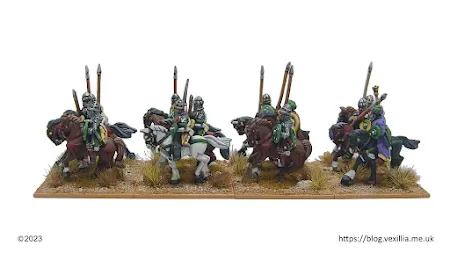When I began building an "Arab Conquest" era army, in February last year, I settled on a North African Arab army (132 in Art de la Guerre) not least because it offers steppe terrain and camel troops.
Needless to say I got sidetracked into painting units for other Arab Empire lists, but I had began to dread preparing the Forged in Battle horses (see below). So I kept putting off these final cavalry. However, they are done now.
These are Abbasiya (Tunisa 795-818 AD) and are heavy cavalry bow (in ADLG) which is unusual as most Arab Empire cavalry are javelin armed. Duncan Head helped me identify these:
"[T]he Abbasiya were a corps raised in Khurasan c.795 by the Abbasids. A detachment were sent to North Africa with Ibrahim ibn al-Aghlab to uphold Abbasid authority, and stayed on when he began to act independently. So they were actually Eastern Iranians, not Arabs. You could do worse than use Ghaznavid ghulam figures."
Up until these, my Arab cavalry were painted in somewhat muted tones. With these I decide to add more colour to mark their Iranian heritage. Even so, I restrained myself and stuck to a mainly a green/yellow theme with only a smattering of red.
I also took the time to do bright patterns on some shields and all the bow cases. The latter was for purely practical reasons. I hope the bright bow cases will be easily visible on the table and differentiate them from the Arab heavy cavalry.
Heavy Cavalry Bow in ADLG
These are useful for two reasons. Firstly, they can evade, unlike heavy
cavalry impact. Secondly, they can shoot. This combination gives
them a number of tactical options (advantages?):
- They can approach heavy infantry and weaken them with shooting before charging home.
- Against impact mounted they can weaken them by shooting and evade if threatened (space permitting).
In other words; they can be a right nuisance; if the dice are with you.
Figure review
The figures are all Forged in Battle's
WE-AG02 Ghaznavid Ghulam Cavalry
and are taken from figures 108 & 110 in Ian heath's classic book "Armies
of the Dark Ages 500-1066".


Figure 108 was especially useful when it came to painting most of the riders as it allowed me to identify the various bits and bobs on the castings; especially the belts and arm bands. I decided against painting the pattern shown in figure 110 but it did suggest a more colourful approach would be appropriate.
In general the riders are excellent but the comments I've made earlier about the horses apply to these figures. In brief they require a lot of work because of poor casting and worn out moulds, and aren't as quick to paint as I'd like.
Finally, this slightly elevated view below is the one I will see most often. It shows the colourful bow cases & quivers which should help identify them during a game.
.png)






They look great, nice job!
ReplyDeleteThanks, Phil.
ReplyDelete